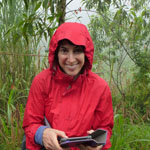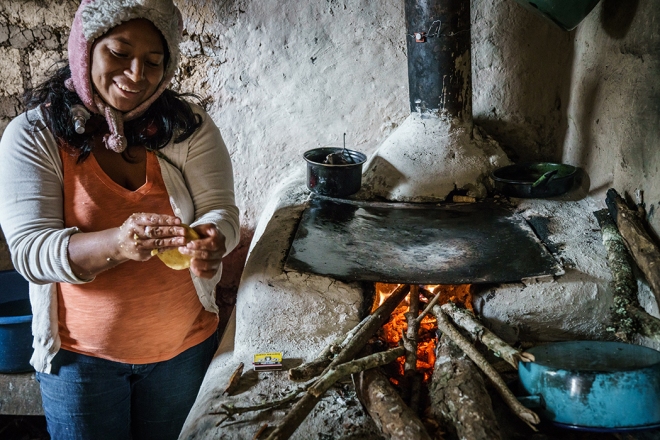
by Bonnie Young, Ph.D., MPH
Postdoctoral Research Fellow
Department of Environmental and Radiological Health Sciences
Colorado State University, Fort Collins, CO
Remember that parable about the boy and the starfish? It went something like this — a boy walked along the beach, picking up starfish and throwing them back into the ocean. A recent storm had passed, and the shore was covered with thousands of them. A man stopped and asked the boy what he was doing, pointing out that he couldn’t possibly help all the starfish. The boy bent down, picked up another one, threw it into the ocean, turned to the man and replied with a smile, “It made a difference to that one.”
Our research in environmental health can feel daunting. Around 2.8 billion people, almost a third of the world’s population, use solid fuel to meet their household energy needs, like cooking and heating (Bonjour et al., 2013). Using inefficient stoves to burn solid fuel — like wood, animal dung, and coal — creates toxic pollution. Imagine hovering over the thick plume of smoke from a campfire for hours a day. Now imagine doing that indoors for the majority of your life. The health impacts from breathing solid fuel smoke are many, such as lung cancer, pneumonia, poor pregnancy outcomes, and cardiovascular effects (Quansah et al., 2017). It is estimated that in 2015, 2.9 million people died prematurely due to their exposure to solid fuel smoke, mostly from cooking (Forouzanfar et al. 2016). In addition to the negative impacts on human health, these inefficient stoves create hazardous pollution for the environment and use resources, such as trees, for fuel.

With a problem this vast, it can be hard to imagine that one project among 230 women in rural Honduras would make a difference.

But we are making good on a promise that was made in 2014 to these women and their community leaders — to select a group of families to receive an improved Justa (pronounced ‘who-sta’) stove and visit them every six months for a few years to see how their pollution levels and health change after receiving a Justa clean cookstove. The Justa is a well-accepted, culturally appropriate stove, which was originally designed by Trees, Water & People, and is now made locally in Honduras. If you ask the women in our study, who had cooked their entire lives on traditional stoves and then received their Justa stove in 2016 or 2017, you’ll hear heartfelt stories of less smoke, less coughing, and cleaner air for the entire family.
Of course, it will be ideal at the end of the study if we see improvements in women’s health, like lower blood pressure, plus reductions in household air pollution and use of less wood-fuel.

Changes like these can have larger public health impacts and potentially lead to stove interventions among entire communities. However, regardless of the bigger picture from this study, I know that the 230 houses that were involved with this intervention are now cooking on cleaner and more efficient stoves, with less smoke inhaled by the entire family, and I feel confident that we have made a difference for those “ones.”
Trees, Water & People and our partner organization, Utz Che’, are working to build 500 clean cookstoves this year in Guatemala. If you would like to help fund a stove for a family or would like to learn more about the importance of this project, click the button below.
References:
Bonjour S., Adair-Rohani H., et al., 2013. Solid fuel use for household cooking: country and regional estimates for 1980-2010. Environm. Health Perspec. 121, 784-790.
Forouzanfar M., Afshin A., et al., 2016. Global, regional, and national comparative risk assessment of 79 behavioural, environmental and occupational, and metabolic risks or clusters of risks, 1990-2015: a systematic analysis for the global burden of disease study 2015. Lancet 388, 1659-1724.
Quansah R., Semple S., et al., 2017. Effectiveness of interventions to reduce household air pollution and/or improve health in homes using solid fuel in low-and-middle income countries: A systematic review and meta-analysis. Environment International 103, 73-90.
The Principal Investigator of this project is Maggie L. Clark, Ph.D., along with Co-Investigator Jennifer L. Peel, Ph.D., MPH. This research is funded by an NIH K99/R00 grant (PI M.Clark).
Bonnie joined the CSU Honduras cookstove team in September 2014 after finishing a 2-year epidemiology fellowship in Hawaii. She earned her Ph.D. in evolutionary anthropology and M.P.H. from the University of New Mexico. As an Anthropologist interested in global health, Bonnie has worked with urban and rural communities around the world, including Mexico, Costa Rica, Paraguay, the Marshall Islands, and the Federated States of Micronesia. Her research interests span environmental health, tuberculosis, and perinatal health. Now as a Postdoc with the cookstove team, Bonnie enjoys the fieldwork in Honduras, working with community leaders, eating corn tortillas, tutoring neighbor kids in English, and doing yoga in her free time.









